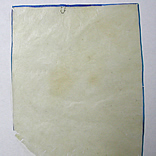This page has been archived and is being provided for reference purposes only. The page is no longer being updated, and therefore, links on the page may be invalid.
|
Using Natural-Occurring Products To Build Hydrogen Fuel Cells
By Sharon DurhamMarch 8, 2006
In research aimed at reducing American dependence on petroleum-based fuels, a group of Agricultural Research Service (ARS) scientists has found a way to replace the petroleum used in today's hydrogen fuel cell membranes with naturally occurring products.
Justin Barone and colleagues in ARS' Environmental Management and Byproduct Utilization Laboratory in Beltsville, Md., have conducted preliminary studies which suggest the possibility of replacing the conventional petroleum-based main membrane in hydrogen fuel cells with biological products.
Hydrogen fuel cells have received a lot of attention as a possible energy conversion mechanism. The coming of what's being called a renewable "hydrogen economy" is being touted as a feasible alternative to current economic reliance on nonrenewable fossil fuels.
In the hydrogen economy, hydrogen fuel cells would replace internal combustion engines in vehicles, and hydrogen would replace gasoline. However, current hydrogen fuel cell technology is heavily dependent on petroleum to make both the fuel cells and the hydrogen fuel.
In biology, membranes surrounding cells routinely conduct hydrogen ions through the cell walls. Borrowing from this idea, Barone and his colleagues have focused their research on bio-based, nonpetroleum membranes made from naturally occurring products to conduct the hydrogen ions moving in and out of fuel cells.
Further development of this type of innovative energy-generation technology would help America move away from the widespread use of petroleum and would address the need to explore alternative energy sources.
ARS is the chief scientific research agency of the U.S. Department of Agriculture.

